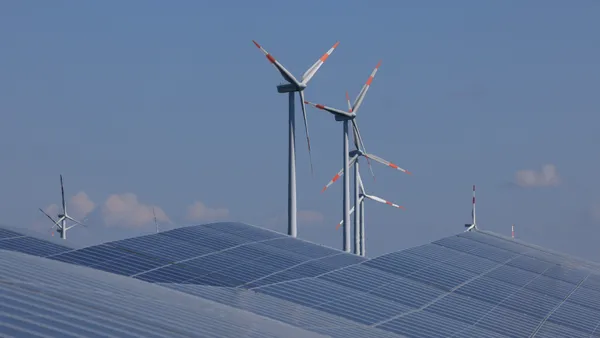Dive Brief:
- Greenhouse gas emissions declined 1.9% in the United States last year, the largest non-pandemic influenced fall since 2016, despite a projected 2.4% economic growth for the country in 2023, according to a preliminary estimate Rhodium Group released Wednesday.
- The environmental think tank said the decline was driven by decreased emissions in the power, residential and commercial sectors, while the transportation and industrial sectors — the two highest emitters — each saw a modest rise in emissions, compared to a 2022 baseline.
- U.S. emissions are still below pre-2019 levels, after the COVID-19 pandemic caused an 11.2% drop in 2020 before two consecutive years of rising emissions. However, the nation is still well off track of its Paris climate accord emissions targets. Rhodium estimates the nation needs to more than triple its rate of emissions decline and sustain that each year until 2030 to reach its goals.
Dive Insight:
It marks the first time since 2020 that national economic growth has been paired with an annual emissions reduction, as recession fears begin to fade. Overall, the nation’s greenhouse gas emissions are down 17.2% from 2005 levels and 6% below 2019 levels, according to the report.
However, Rhodium said the U.S. will need to average 6.9% in emissions reductions every year to hit its 2030 emissions reductions targets.
The power sector had an 8% drop in emissions last year, with natural gas and renewables both seeing growth in the year — Rhodium estimates coal provided as much of the nation’s power as it last did in 1969. Coal made up just 17% of the nation’s power generation in 2023, with nuclear power out-generating coal for just the second time in history.
Rhodium analysts said natural gas generation grew twice as fast as renewable energy in 2023. Still, the solar sector is expected to hit another record year with utility-scale battery installations topping their 2022 numbers by the end of Q3 2023. The second largest drop in emissions came in the buildings sector, which saw a 4% decline that the group attributed to reduced fuel demand during a winter that, through 2023, has been warmer than average.
The nation has a lot of work to do if it will live up to its 2030 greenhouse gas emissions targets included in the Paris Agreement. Rhodium’s analysts said “for now” 2023’s emissions decline is a “step in the right direction.”
“But the deadline for the US 2030 climate target under the Paris Agreement of a 50-52% reduction in GHG emissions below 2005 levels is rapidly approaching, and achievement of that goal looks ever more challenging absent a major new policy push,” the report said.
Last fall, the nation’s Fifth National Climate Assessment warned the U.S. is not on track to meet national or international climate goals, unless it creates steeper declines in greenhouse gas emissions. The congressionally mandated report also cautioned that the repercussions of climate change are extensive and already impacting every region of the nation because of sustained fossil fuel use and the lack of emissions reductions.
The analysts also noted that the expected emission reductions resulting from the Inflation Reduction Act and Infrastructure and Jobs Act have yet to come to fruition, and will take years to fully realize. While agencies spent much of last year working out how to structure the tax credits for the $369 billion in clean energy incentives in the Inflation Reduction Act, Rhodium said the “early investment data looks promising.”
An analysis of nine major climate modelers estimated last year that the effects of the climate bill alone could slash U.S. greenhouse gas emissions by between 43% and 48% by 2035.
















